General Introduction
In October 1983, Marian Fitzgibbon, then Mid-West Arts officer, circulated a proposal document to interested parties in the region, which outlined a "National Pilot Community Arts Scheme"-tentatively called 'Art Attack' to be organised in Ennistymon, Co. Clare from October 1983 to December 1984.
Why Ennistymon? The town itself (pop. 1,100) is very attractive; once an important commercial centre for its hinterland, it has in recent times suffered a certain deterioration for reasons which are mainly sociological. In spite of or perhaps because of this, the town has retained many of the old shop-fronts and character typical of a small Irish town.
The project was to be run by a community-based action-group with the professional assistance of Mid-West Arts, and it was hoped that the scheme would result in the following:
(a) a greater appreciation of the town and its environs; (b) a finer sensitivity of things visual;
(c) a tangible improvement of the environment;
(d) the enrichment of the community both artistically and socially;
(e) a visual Arts Festival of
national significance to be held during the final two weeks of August 1984.
ORIGINAL PROPOSAL TO THE ARTS COUNCIL
The programme of events which finally constituted 'Ennistymon '84' bore a fair degree of resemblance to the proposal which was submitted to the Arts Council for funding, indicating the importance of a strong plan on which such a scheme should be based.
The various chapters in this book will show to what extent we were able to adhere to the original plan, which is summarised below.
1. Education Programme: This was to be the thread of activities which would tie the project together from December '83 to August 84. To be devised and administered by a sub-committee, the programme was to include (a) art classes and lectures, (b) weekend workshops, (c) visits by artists, (d) an architectural project for children, (e) art history, (f) children's paint-ins, (g) art competitions and (h) film and slide shows.
2. Architectural Survey and Exhibition: It was hoped that this survey, conducted by a team from the U.C.D. School of Architecture, would provoke a greater con- sciousness of the man-made environment. Aesthetically, Ennistymon has more to offer than many Irish towns, and in the absence of galleries or museums it was considered that the appearence of buildings and the composition of streets must have a formidable influence on visual sensibility.
3. Sculpture Playground: Under an AnCo Community Youth Training Programme or a Youth Employment Agency Scheme it was planned to install a sculpture playground in the town. The young people employed on this project would work under the direction of a sculptor. This amenity would introduce sculpture as an ordinary practical element of everyday life while also enhancing the town. Other tasks could also be undertaken under this scheme with the aim of improving the environment.
4. Murals: It was hoped to introduce 4 public murals under the supervision of professional artists and executed by:
(1) Junior primary school
(2) Senior primary school
(3) Junior cycle secondary school
(4) Senior cycle secondary school.
The Arts Council 'Paint on the Wall' scheme had already amply demonstrated the effect a mural can have on the school environment. By the judicious choosing of sites and artists, public murals could do the same for the community and, like the sculpture playground, would permanently enhance the town.
5 National Touring Exhibition: The Clare landscape has been a source of inspiration for many artists. As the landscape underlines and invades the man-made structures, it was deemed appropriate to celebrate this influence by presenting an exhibition of four major artists which would open in Ennistymon and tour four urban centres, thereby reversing the usual trend while establishing poetic justice.
The exhibition would feature the works of Seamus Coleman, Barrie Cooke, Anne Madden and Camille Souter; and while inviting people inside to look at the personal individual responses to the landscape, would hopefully incite them to re-examine the source.
6. "Just Looking": During the final two weeks of August 1984, the town itself would become a gallery. Art students and artists from the region would create works for the windows of the Main Street. The theme of this exhibition would be the transformation of what is familiar or the 'poeticisation' of the ordinary. The artists would use the materials normally dealt with in the shop or other materials to comment directly or obliquely on the activity of the shops or business. This project would involve contact between the shop-owners and the artists, and in a more aggressive fashion than is usual in an art gallery, between the artists and the public.
7. Craft Exhibitions: Because of the relationships between the visual arts and crafts and because of the number of craftworkers in Co. Clare, a display of quality crafts produced in the area would be held during the final two weeks of August 1984. This would in fact be the culmination of a series of smaller exhibitions by individual craftworkers and artists held between January and July, 1984.
8. Community Artists: From August to December it was hoped that a community artist would work in Co. Clare, consolidating achievements and undertaking new pro- jects. This scheme, piloted in Galway/Mayo in Summer 1983 would ensure that the potential unearthed between October '83 and August '84 would be given a chance to develop and continue.
9. Visual Arts Festival: 'Ennistymon '84' was to be celebratory in method, culminating in a 'blitz' of visual arts events in the last two weeks of August, when each of the individual projects would be completed and on view to the public and when a series of exhibitions, lectures, and other events would highlight the achievements of the previous months.
Finally, the 'Ennistymon '84' project sought to involve all sectors of the community in the town: Shopkeepers, housekeepers, farmers, tradespeople, the unemployed, children and those already involved in community service, as well as all levels of expertise in the visual arts.
To quote from the proposal: "The only hope for the arts in Ireland is in an integration of resources-both public and private-such as the project attempts; and a widening of the base through an increase in the number of those interested in and involved in the arts, an aim which 'Ennistymon '84' seriously addresses. On this depends the success of the scheme."
On March 5, 1984, the Arts Council
sanctioned a grant of £8,850 to the Ennistymon '84 Community Arts project. From
this point on, there was no going back.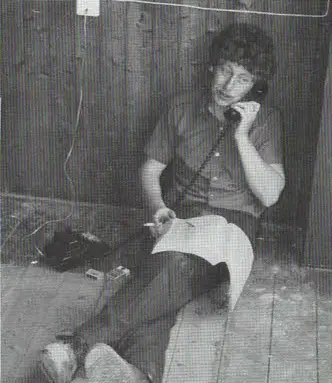
THE FIRST PUBLIC MEETING
In the Autumn of 1983, Patricia Jackson was taking part in the Irish Museums Trust/AnCo course in Arts Administration, and as part of a work experience programme was placed with Marian Fitzgibbon and Mid-West Arts. Patricia's task was to lay the ground work in Ennistymon for a Public Meeting which would launch the arts project. Armed with the draft proposal and a contagious enthusiasm she came to Ennistymon and began that most daunting of tasks: i.e. 'meeting people'.
And people were certainly met.., on the street and in shops, houses, and pubs, over the phone, over coffee, sherry and larger tumblers of tongue-looseners; and much credit is due to Patricia's professionalism that promises and half-promises were extracted from so many people to attend a public meeting on October 26.
When the night finally came around, the room at the Falls Hotel where the meeting was to be held was ominously empty, but with typical Irish unpredictability, a healthy crowd of about 50 finally assembled there to listen to Marian Fitzgibbon, Medb Ruane (Arts Council Visual Arts Officer), and Noel Crowley (Clare County Librarian) formally introduce the Arts Project to the people of the district.
The attendance consisted of an encouraging mixture of people, representing most of the town's committees and interest groups both with and without a prior interest in things artistic; and reaction to the proposed community arts scheme was encouraging enough to establish there and then the core of an Action Group. As is the norm at this type of meeting, people were mostly "volunteered", but the interest appeared genuine, and it seemed now as if the dream could not fail to become reality of a sort.
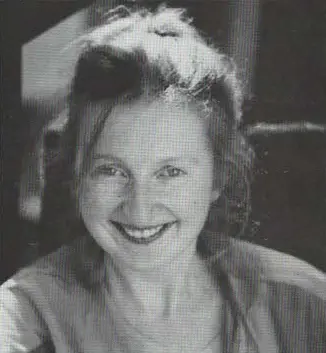
THE COMMITTEE
Following the public meeting, a committee-cum- action group was established which consisted of no less than 19 people. On retrospection we cannot see any reason why any committee should be so large, and indeed in the case of Ennistymon '84, the sheer bulk of this grouping was in time to prove a little too large for comfort.
The original committee was structured as follows: 2 Co-ordinators, 1 Secretary, 1 Treasurer, Education sub-committee (3 members), Local Exhibitions sub- committee (3 members), Crafts sub-committee (2 members), National Touring Exhibition sub-committee (2 members), Publicity sub-committee (2 members), and Shop-windows sub-committee (4 members).
From the start it became apparent that the committee would have to reduce or be reduced. There were it seems two main reasons for this; firstly, a number of people came to realise that their own businesses or occupations would not allow them to give the time which the project was demanding even in those early days. This was particularly true of the shopkeepers and the artists/ craftworkers who in this region depend so much on the summer trade for their livelihoods.
Secondly, from an early stage there appeared to be a rift within the committee between the artists and the 'non-artists'. The reasons remain elusive, though one opinion is that some of the artists may have felt that due recognition would not be forthcoming from the dual forces of (a) the professional office of Mid-West Arts in faraway Limerick; and (b) the so-called 'pseudo- professionalism' of the non-artist members of the local committee.
Or in other words, a continuous doubt surrounded the affairs of the Ennistymon '84 committee, concerning its real intentions with regard to the use of local artists and craftspeople. The 'Limerick influence' was regularly questioned and rightly so-but the committee stalwarts remain adamant that they continued to be as impartial as possible when it came to selecting personnel for various events. It was never intended that the Ennistymon '84 project would be a showcase for local talent alone, it was equally important that the public be confronted with a variety of artforms and a variety of artists from outside the region.
But let it not go unrecorded that
the committee or what remained of it was enormously appreciative of the input
made by the artists and craftspeople of North- Clare, who without exception
gave generously of their time and skills, without which this intended community
arts project could not have succeeded. Notwithstanding the reluctance of
certain people to row in with the committee and its work, the show nevertheless
did go on.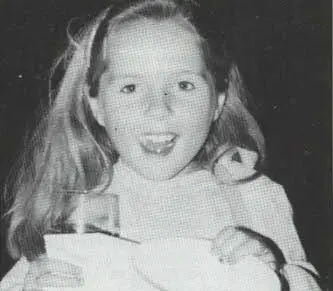
CO-ORDINATION
In time, our two co-ordinators became one, our publicity people reluctantly withdrew, the National Touring Exhibition was a non-starter-indeed the only sub-committee which could be said to have survived was that of the shop windows. The others became an amalgam of available hands; willing personnel were recruited to each particular cause as required. In actual fact, the sub-committee structure never really worked for us. It was a case of vague responsibilities being imposed on people before they could realise what was involved. When the committee was at its best, in full stride, tasks were apportioned or assumed in accordance with who was available at the time, and who was willing to get involved. When morale was high, volunteers were always at hand; and when morale was low, there were always the few stalwarts who could carry it through.
As the weeks and months passed, we began to talk and joke about the 'executive committee', only to find that this indeed was the most economical and constructive way of reaching decisions and resolving disputes. General committee meetings, as is their norm, tended to be quite a chore at the best of times, and useless at their worst. Therefore, the 'core' committee, usually comprising the Regional Arts Officer, the Project Administrator, the committee Co-ordinator. and the Secretary were generally able to do much of the dirty work in advance of committee meetings, where the finer points could then be worked out. A pity we did not consider this at the start.
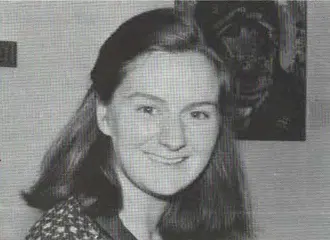
Una McCarthy, Ennistymon '84 Administrator and a familiar figure in Ennistymon during 1984
ADMINISTRATION
Administration became a dubious term within the rank and file of the Ennistymon '84 committee. Initially, the definition was quite clear. As already stated, Patricia Jackson's role was straight-forward in that she administered locally for Mid-West Arts during the period when the project was being established in the town.
Patricia's successor gave a somewhat different hue to the post of Administrator. Una McCarthy arrived in town with little more than her dole money in her pocket. Willing to assume the role of volunteer administrator, she gradually found herself adopting many mantles: secret- ary, receptionist, campaigner, policy-maker, chairperson, motivator, landlady, P.R. officer. Essentially, she became the committee's best friend. After some time Una was officially employed as administrator under a Department of Labour Youth Employment Scheme.
At this stage, administration and co-ordination be- came the portfolio of the Ennistymon '84 triumvirate: Marian Fitzgibbon (Regional Arts Officer), Una McCarthy (Administrator), and John Doorty (Co-ordinator). The setting up of the Arts/Information office further confused the already complex set of roles which were never really defined by either the local committee or the Mid-West Arts. While there were occasions when the overlap of roles did not work too well (See, chapter on Arts/ Information Office), generally speaking, because of the characters involved, personnel were competently and successfully interchangeable.
One interesting fact of this 'executive' structure was that there were, at one stage, three paid administrators overseeing the decisions and activities of the volunteer committee. The roles of Secretary and Treasurer were more or less absorbed by the administrators, and the personality of the committee became a shadow of its former self. It is the opinion of this commentator that while Ennistymon '84 at no time had a true committee or action group as originally intended, nonetheless, the nature of the project, with all its uniqueness, eventually needed this 'professional' input to carry it through to its ambitious goal.
The eventual committee and its structure varied significantly from that which was proposed at the first meeting. The changes were to a large extent natural, and symptomatic of the dynamism of the whole Ennistymon '84 project.
For the sake of the history books, the team which saw the project through to the culmination in August was:
Mid-West Arts Officer........ Administrator
Co-ordinator
Secretary
Treasurer
Education
Shopfronts
Local Exhibitions
Marian Fitzgibbon
Una McCarthy
John Doorty
Brian Doyle Sue Denihan
Pat Doherty Dermot Twohig Pat Wall
Kathryn Comber Carmel Kenny Yvonne Bartlett
Jacki Hersey
General
Bonnie Whyte Mal Whyte
Vincent Wall
David Brown
VOLUNTARY SERVICE INTERNATIONAL
V.S.I. is an organisation which aims to break down barriers international, racial, sectarian-by working together in service to the community. To this end V.S.I. offers a range of voluntary work opportunities in Ireland, Europe, Africa and Asia, and Ennistymon '84 was delighted to have been able to offer the opportunity for two workcamps to take place in the town during the project.
The first group of volunteers
arrived on June 17, and stayed in a house in Lahinch; while the second group
arrived on August 5, and set up camp in the Vocational School in Ennistymon.
The volunteers came from Ireland, Britain, Europe, the Middle East, Africa, and
America, lending an international flavour to our com- munity arts project. Work
included preparation of venues, preparing shop-windows for Just Looking'
exhibition, assisting with sculpture playground team, cleaning the river,
tidying the sculpture garden, framing photographs, and participating in a
number of events. Our thanks to Voluntary Service International and to all the
volunteers.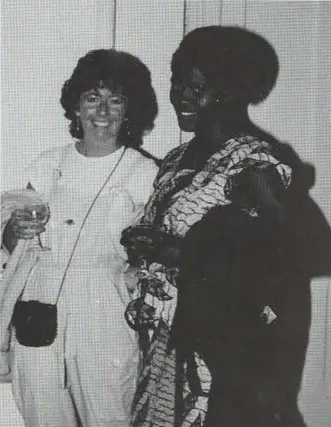
V.S.I volunteers at the opening of the Visual Arts Festival